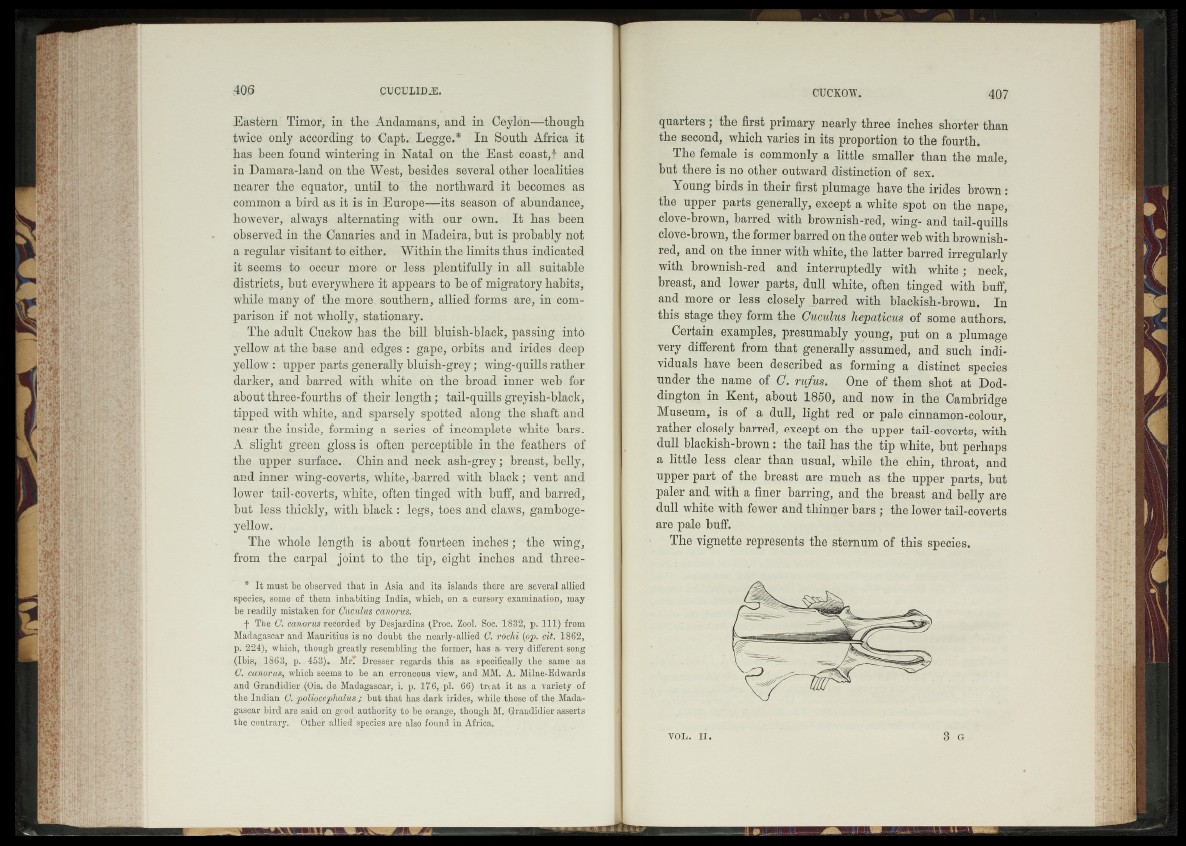
Eastern Timor, in the Andamans, and in Ceylon—though
twice only according to Capt. Legge.* In South Africa it
has been found wintering in Natal on the East coast,f and
in Damara-land on the West, besides several other localities
nearer the equator, until to the northward it becomes as
common a bird as it is in Europe—its season of abundance,
however, always alternating with our own. It has been
observed in the Canaries and in Madeira, but is probably not
a regular visitant to either. Within the limits thus indicated
it seems to occur more or less plentifully in all suitable
districts, but everywhere it appears to be of migratory habits,
while many of the more southern, allied forms are, in comparison
if not wholly, stationary.
The adult Cuckow has the bill bluish-black, passing into
yellow at the base and edges : gape, orbits and irides deep
yellow : upper parts generally bluish-grey; wing-quills rather
darker, and barred with white on the broad inner web for
about three-fourths of their length; tail-quills greyish-black,
tipped with white, and sparsely spotted along the shaft and
near the inside, forming a series of incomplete white bars.
A slight green gloss is often perceptible in the feathers of
the upper surface. Chin and neck ash-grey; breast, belly,
and inner wing-coverts, white, -barred with black; vent and
lower tail-coverts, white, often tinged with buff, and barred,
but less thickly, with black : legs, toes and claws, gamboge-
yellow.
The whole length is about fourteen inches ; the wing,
from the carpal joint to the tip, eight inches and three-
* I t must be observed that in Asia and its islands there are several allied
species, some of them inhabiting India, which, on a cursory examination, may
be readily mistaken for Ouculus canorus.
f The C. canorus recorded by Desjardins (Proc. Zool. Soc. 1832, p. I l l ) from
Madagascar and Mauritius is no doubt the nearly-allied C. rochi (op. cit. 1862,
p. 224), which, though greatly resembling the former, has a- very different song
(Ibis, 1863, p. 453). MrT Dresser regards this as specifically the same as
C. canorus, which seems to be an erroneous view, and MM. A. Milne-Edwards
and Grandidier (Ois. de Madagascar, i. p. 176, pi. 66) trta t it as a variety of
the Indian C. poliocephalus ; but that has dark irides, while those of the Madagascar
bird are said on gcod authority to be orange, though M. Grandidier asserts
the contrary. Other allied species are also found in Africa.
quarters; the first primary nearly three inches shorter than
the second, which varies in its proportion to the fourth.
The female is commonly a little smaller than the male,
but there is no other outward distinction of sex.
Young birds in their first plumage have the irides brown:
the upper parts generally, except a white spot on the nape,
clove-brown, barred with brownish-red, wing- and tail-quills
clove-brown, the former barred on the outer web with brownish-
red, and on the inner with white, the latter barred irregularly
with brownish-red and interruptedly with white; neck,
breast, and lower parts, dull white, often tinged with buff,
and more or less closely barred with blackish-brown. In
this stage they form the Cuculus hepaticus of some authors.
Certain examples, presumably young, put on a plumage
very different from that generally assumed, and such individuals
have been described as forming a distinct species
under the name of C. rufus. One of them shot at Dod-
dington in Kent, about 1850, and now in the Cambridge
Museum, is of a dull, light red or pale cinnamon-colour,
rather closely barred, except on the upper tail-coverts, with
dull blackish-brown; the tail has the tip white, but perhaps
a little less clear than usual, while the chin, throat, and
upper part of the breast are much as the upper parts, but
paler and with a finer barring, and the breast and belly are
dull white with fewer and thinner bars ; the lower tail-coverts
are pale buff.
The vignette represents the sternum of this species.